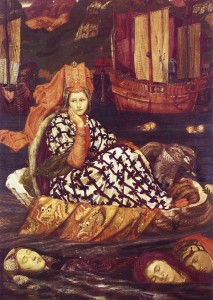 Having a sometimes-strong streak of iconoclasm, I skipped Gregory Maguire’s Wicked: The Life and Times of the Wicked Witch of the West (Harper, 2000; all quotations are taken from this edition) when it first appeared to such huge acclaim and popularity in 1995. Admittedly, I’m not a huge fan of The Wonderful Wizard of Oz on the best of days, although I’ve tried to connect with it if for no other reason than Geoff Ryman’s Was and the fact that it’s an important work in the history of American fantasy. Thus I let Wicked pass me by, despite recommendations by friends, colleagues, and students; despite its eventual adaptation into a Broadway musical, which was of course followed by recommendations to see that incarnation; etc. So, when Elizabeth Searle recommended I read Wicked to examine how Maguire adapts his source material, I have to confess that I kind of sighed inwardly: now I had to read this book that I had successfully avoided for so many years. Warning: Spoilers to follow.
Having a sometimes-strong streak of iconoclasm, I skipped Gregory Maguire’s Wicked: The Life and Times of the Wicked Witch of the West (Harper, 2000; all quotations are taken from this edition) when it first appeared to such huge acclaim and popularity in 1995. Admittedly, I’m not a huge fan of The Wonderful Wizard of Oz on the best of days, although I’ve tried to connect with it if for no other reason than Geoff Ryman’s Was and the fact that it’s an important work in the history of American fantasy. Thus I let Wicked pass me by, despite recommendations by friends, colleagues, and students; despite its eventual adaptation into a Broadway musical, which was of course followed by recommendations to see that incarnation; etc. So, when Elizabeth Searle recommended I read Wicked to examine how Maguire adapts his source material, I have to confess that I kind of sighed inwardly: now I had to read this book that I had successfully avoided for so many years. Warning: Spoilers to follow.Obviously, Maguire’s choice to delay the beginning of Baum’s material gives him ample time (330 pages) to develop Elphaba and make her more sympathetic to the audience. But she isn’t more sympathetic, not really; Maguire keeps us at an emotional remove from Elphaba for most of the novel, which is told mostly in third-person limited point of view, albeit by shifting character perspectives (sometimes he shifts into omniscient point of view, but he tends to follow one character per section). We don’t actually get into Elphaba’s head until page 226 (long after, I would argue, some of the more interesting parts of her story, which is a little disappointing), and thereafter Maguire shifts his character point of views with more frequency than the first half of the novel, when we follow pretty strictly Melena and Frex in “Munchkinlanders,” Galinda and Boq in “Gillikin,” and then Fiyero in “City of Emeralds.” “In the Vinkus” marks several more points of view, though they tend to shift more and with less pattern than the first three sections: Elphaba, Sarima, Nor, Sarima’s younger sisters, and a little of the boys (Liir, Manek, Irji).
We don’t get into Elphaba’s head until after she ends her stay with the maunts and begins a quest for forgiveness from Sarima for Fiyero’s death. Prior to that point, Elphaba is as much a cipher to us as she is to the rest of the characters, although the multiplicity of perspectives helps give us a round image of Elphaba. She is a strange creature as much for her green skin as for her prickly relationship-style, and Fiyero sees her most clearly as her lover. Even many months into their relationship, Fiyero “stalked her again. Love makes hunters of us all” (215), a proverbial idea, to be sure, but also indicative of Elphaba’s otherness: she is perhaps ultimately as unknowable to her friends and lover as Animals are to humans. But largely Elphaba seems defined by her political passions, particularly the plight of Animals in Oz under the Wizard’s tyranny but also to some extent in relation to issues of gender. I wish Maguire had done more with the gender issues because certainly Oz seems to be similar to America at the turn of the 20th century in its perspectives and could use a little more suffrage. For example, Fiyero reflects on the differences between his wife Sarima and his lover Elphaba:
He chose more gifts for the kids and for sulky Sarima, that well-fed malcontent, that monster. He missed her a little; his feelings for Elphaba seemed not to vie with those for Sarima, but to complement them. No two women could be more unlike. Elphaba demonstrated the proud independence of Arjiki mountain women that Sarima, married so young, had never developed. And Elphie wasn’t just a different (not to say novel) provincial type—she seemed an advance on the gender, she seemed a different species sometimes. (207)
This idea of Elphaba as “an advance on the gender” comes from her lover, and the use of the word “advance” suggests that Elphaba might be a revolutionary—except that she doesn’t really become that revolutionary with her passion and intelligence; she’s stymied and stalled by her own choices in life, which she acknowledges have been regularly—perhaps unfailingly—the wrong ones. Maguire presents Elphaba as a hero in the semi-Classical vein: she is capable of great things and yet she is stopped by her tragic flaw, which, as it happens, is herself: she is her own worst enemy. She sees that “There was much to hate in this world, and too much to love” (228), and she refuses to submit to the latter and tries to remove herself from the former, the end result being a tragedy that sees the deaths of many people Elphaba loves as well as her own. I kept waiting for her to come into real power, to effect change, and Maguire confounds, in the best way, my reader’s expectations.
The cover copy of the novel raises the question, “And what is the true nature of evil?” which Maguire doesn’t begin to explicitly address until the second half of the novel (the Animals debate in the first half of course leads into these more explicit discussions of evil in the second). Maguire’s analysis of evil comes about in curious turns, some of which are a little too didactic for my taste. In one of the best of these analyses, Oatsie Manglehand, the wise caravan leader, says one night,
“You old fools, the Oziad is just a frilly, romantic poem of older, harsher legends. What lives in folk memory is truer than how some artsy poet says it. In folk memory evil always predates good.”
“Can this be true?” asked Igo, with interest.
“Surely there is the handful of nursery märchen that start, ‘Once in the middle of a forest lived an old witch’ or ‘The devil was out walking one day and met a child,’” said Oatsie, who was showing that she had some education as well as grit. “To the grim poor there need be no pour quoi tale about where evil arises; it just arises; it always is. One never learns how the witch became wicked, or whether that was the right choice for her—is it ever the right choice? Does the devil ever struggle to be good again, or if so is he not a devil? It is at the very least a question of definitions.”
“It certainly is true that tales of the Kumbric Witch abound,” agreed Igo. “Every other witch is just a shadow, a daughter, a sister, a decadent descendant; the Kumbric Witch is the model further back than which it seems impossible to go.” (231)
(I should point out that I object to Maguire’s use of clearly non-Ozian terminology, such as the German “märchen” or the French “pour quoi” and later on page 398 Elphaba’s use of the Latin “Malleus Maleficarum.”) Of course, Maguire in this quotation is giving the reader the signpost by which to read the novel, as we are learning indeed “how the witch became wicked.” And the central question, for both the reader and for Elphaba, is how the choices Elphaba makes create the Wicked Witch of the West, as she will become known. Elphaba has tried to do the right thing, as she sees it, but usually with disastrous results. And when Dorothy arrives—the force of “good,” as Baum would have it—only then does Elphaba respond with “evil” choices (claiming to have murdered the already-dead Madame Morrible, for example), making us think about Oatsie’s claim that evil always predates good. Elphaba wonders if she—and Glinda and Nessarose—have been under a spell: “For that matter, was Elphaba herself merely a playing piece of a higher, evil power?” (288). Has the decisions she’s made been her own or the commands of someone else, such as Madame Morrible or her birth father, the Wizard? Ultimately, this line of thinking allows Elphaba an out for her “evil” behavior, her poor choices, but I don’t think the reader is fooled by it: Elphaba has made her own choices but is, in some ways, unwilling to deal with them and move beyond them, which means she is no more evil than the rest of us (or as evil as we all are). Evil is about choices and perception, and we as people—and as writers—should always keep in mind that people never think of themselves as evil.
The novel presents a fascinating imagining of the life that created the Wicked Witch of the West along with an interesting take on art. Although Oatsie Manglehand may look down her nose at the “artsy poet,” the novel is a long examination of how someone can make their life into art by a string of particular choices, just as the artist makes nothing into art by choices. After the long—and perhaps most tedious—discussion on the nature of evil at Avaric’s dinner table, Elphaba concludes the conversation by having the last word: “Maybe evil is an art form” (371). If so, I’d argue that Elphaba is a failed artist, but we can give her points for trying.
Note: I saw the musical Wicked in London and was amazed (perhaps a little dismayed) at how different it was from the novel, but perhaps that’s because I’d only just finished the novel a couple weeks before I left the States. Watching the musical did give me some more to think about in terms of how one makes a successful adaptation, as I thought the musical had a life all its own.





